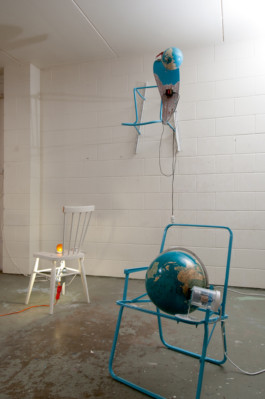
Proposition #2: Octagon Room
A virtual installation in the Octagon Room at the Royal Observatory, Greenwich, England
By Paul Cullen Archive, 2022–2023
This interactive, virtual project realises a speculative proposal made by artist Paul Cullen in 2011 to install works from his r/p/m (revolutions per minute) series around the globe at historical centres for scientific study (sites that the artist had visited and researched). In Proposition #2: Octagon Room, Cullen proposes situating four r/p/m sculptures with motorised rotating components, including plastic gherkins, orange, pear and a bucket at the Royal Observatory in Greenwich, England. Propositions #1, #3, #4, and #5 locate artworks at the Eisinga Planetarium in Franeker, the Netherlands; Musick Memorial Radio Station on Naupata Reserve, Aotearoa; Linnaeus Garden in Uppsala, Sweden; and the Alhambra in Granada, Spain. The Paul Cullen Archive will realise propositions 1–4 as virtual installations between December 2022 and March 2023.
Cullen initially presented these hypothetical site-related r/p/m installations as a series of five interchangeable gatefold covers wrapping the publication Paul Cullen: r/p/m, published by split/fountain in 2011. This publication includes documentation of Cullen's r/p/m series installed in the artist's Panmure studio in Tāmaki Makaurau. Describing the works, he notes that: "each sculpture proposes, though fails to perform, some kind of rational purposes such as demonstration, observation or measurement."








For Digital r/p/m, the Paul Cullen Archive has drawn on the instructional notes and diagrams provided by the artist on the r/p/m publication covers. Proposition #2: Octagon Room includes a written concept, site images, selected r/p/m sculptures, and annotated floor plan indicating the placement of works. This two-sided publication cover is pictured above. The artist's concept reads:
"Established in 1675 the Royal Observatory Greenwich was the first purpose built scientific research facility in Britain built, for a cost of £520, largely out of recycled materials. Within Flamsteed House, the original observatory building, is the Octagon Room which housed equipment intended for use in solving the problem of longitude. Today the functions of the Royal Observatory have been moved elsewhere and the Octagon Room is used for the display of the early scientific equipment once used there. A failed bomb attack on the Observatory in 1894 was the inspiration for Joseph Conrad’s novel The Secret Agent."
"This proposition locates four of the Revolutions per Minute sculptures in the Octagon Room: r/p/m (3), Orange Theory, Fox Circle and Brains Pear Sculpture. Each sculpture proposes, though fails to perform, some kind of rational purpose such as demonstration, observation, or measurement."
"The Royal Observatory Greenwich is in southeast London and has the coordinates 51º 28' 38" N, 0º 00' 00” W. The location of the observatory is the basis for the International or Greenwich Meridian although modern reference systems have seen the meridian move 102.5 metres eastwards.”
—Paul Cullen, 2011
Using LiDAR and photogrammetry, the archive has created 3D models of artworks in Cullen's former studio and collaborated with offshore creatives to realise scans of international locations. These elements congregate in the open-source platform Mozilla Hubs (scroll down for the Mozilla Hubs room link). The r/p/m virtual installations explore how notions of space are simultaneously anchored within a given moment while also interlaced with historical traces left behind.






The Octagon Room model is situated directly on the r/p/m proposition #2 publication cover, over the artist's floor plan indicating the proposed placement for Brains Pear Sculpture (J), The Orange Theory (H), r/p/m [3] (Q), and Foxcircle (I). In the floor plan, Cullen also indicates the position of the time ball (located outside atop the Octagon Room), the entry door and stairs, and various antique objects within the space, including three clocks, a telescope and an astronomical quadrant. However, the placement of some of these objects have moved in the 2022 scan of the Octagon Room.
Out of the four r/p/m pieces Cullen proposed for The Octagon Room, only Fox Circle and The Orange Theory are held by the Paul Cullen Archive. Therefore, these were the only works available to scan. Brains Pear Sculpture is excluded from the virtual Octagon Room installation. However, we opted to create a digital reconstruction of r/p/m [3]. This is assembled from 3D scans of a found bucket (sourced from the artist's studio) and the Formica table from Cullen's sculpture Moon (2013). However, we acknowledge that the bucket and table both differ from those used by Cullen in his original r/p/m [3] sculpture.
Unfortunately, Mozilla Hubs was shut down on May 31, 2024, so the four virtual installations can no longer be viewed.

Proposed artworks to be situated in the Octagon Room: I, Q, J, H

J
Brains Pear Sculpture, 2007
Book, metal frame, motor, cable ties, plastic pear and electric cord
510 x 350 x 280 mm

Q
r/p/m [3], 2010
Plastic bucket, formica table, cable ties, electric motor and cord
980 x 650 x 765 mm

H
The Orange Theory, 2007
Chair, artificial orange, aluminium foil, cable ties, rubber band, electric light and cord, electric motor and cord
825 x 400 x 380 mm

I
Fox Circle, 2007
Chair, ruler, wood, brass tube, plastic film, plastic gherkins, cable ties, electric motor and cord
825 x 615 x 380 mm
Models of artworks situated in the Octagon Room
Click the links below to view, rotate and scale individual models.
Digital r/p/m credits and acknowledgments
Artwork models by Paul Cullen Archive (Tāmaki Makaurau, Aotearoa / New Zealand)
Artwork animation and 3D models of ladder, telescope and sextant by Felipe Pulfer (Buenos Aires, Argentina)
Octagon model by Phoenix Tui (London, England)
r/p/m publication covers (2011): artwork by Paul Cullen, design by Jayme Yen and Layla Tweedie-Cullen.
This online project is part of Huarere: Weather Eye, Weather Ear, Te Tuhi (Pakuranga, Tāmaki Makaurau), curated by Janine Randerson as a contribution to the World Weather Network, 2022–2023.
Thanks to
Stuart Bertolotti-Bailey
p. mule
Janine Randerson
p. mule et al
Produced with support from Creative New Zealand.
Other r/p/m propositions






